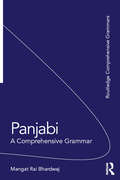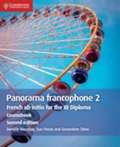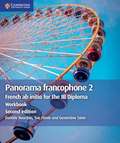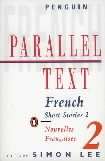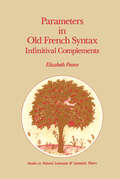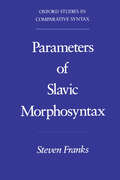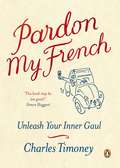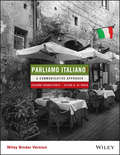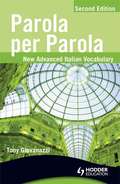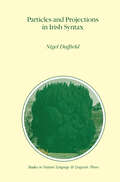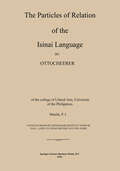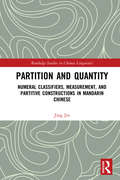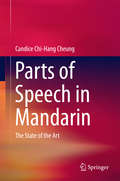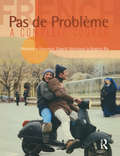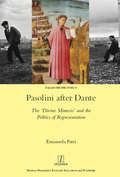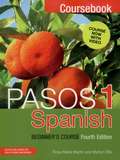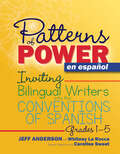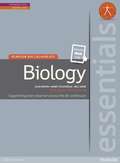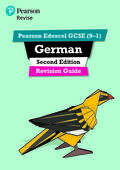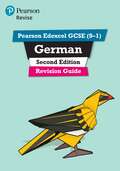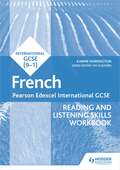- Table View
- List View
Panjabi: A Comprehensive Grammar (Routledge Comprehensive Grammars)
by Mangat BhardwajPanjabi: A Comprehensive Grammar is a complete reference guide to Panjabi grammar. It presents a fresh, accessible and thorough description of the language, concentrating on the real patterns of use in modern Panjabi. The book moves from the script and sound through morphology and word classes to a detailed analysis of sentence structures and semantic features. The volume is organized to promote a thorough understanding of Panjabi grammar. It offers a stimulating analysis of the complexities of the language, and provides full and clear explanations. Throughout, the emphasis is on Panjabi as used by present-day native speakers. An extensive index and numbered paragraphs provide readers with easy access to the information they require. Features include: detailed treatment of the common grammatical structures and parts of speech extensive exemplification particular attention to areas of confusion and difficulty Gurmukhi script and transliteration provided throughout additional chapter on the Shahmuki script Panjabi: A Comprehensive Grammar is an essential reference source for the learner and user of Panjabi. With clear and simple explanations it will remain the standard reference work for years to come for both learners and linguists alike. A Workbook and Reader to accompany this grammar can be downloaded from https://www.routledge.com/products/9781138793866. *Please note that, due to unforseen circumstances, the Workbook and Reader have been delayed.*
Panorama Francophone 2 Coursebook (Ib Diploma Ser. (PDF))
by Danile Bourdais Sue Finnie Genevive TalonThis coursebook helps students explore the new IB Diploma ab initio themes (first examination 2020): identities, experiences, human ingenuity, social organisation and sharing the planet. Designed for students with no previous background in French, this coursebook develops well-rounded language skills and encourages learners to become open minded, international citizens – reflecting the mission of the International Baccalaureate. Authentic texts and vibrant images from around the world are specifically selected for older teenagers and to give them an insight into different cultures and viewpoints. Answers to the coursebook activities and audio accompanying the listening exercises are in the teacher's resource.
Panorama Francophone 2 Workbook (Ib Diploma Ser. (PDF))
by Danile Bourdais Sue Finnie Genevive TalonThis workbook provides students with extra practice as they explore the five themes from the new IB Diploma Language ab initio guide (first examination 2020): identities, experiences, human ingenuity, social organisation and sharing the planet. It helps students further develop their French language skills with additional exercises that complement the activities in the coursebook, with a focus on grammar and vocabulary. The workbook is ideal for teachers needing differentiated exercises for their class and can be used for independent study and revision. Answers to the workbook activities are in the teacher's resource.
Parallel Text: Nouvelles Francaises
by Simon Lee Various AuthorsThese eight stories by leading 20th century French writers offer fascinating insights into French life and literature and are accompanied by a parallel English text, making them valuable for both French and English language students.Among the diverse and entertaining stories in the collection are the wistful masterpiece ‘Green Tobacco’ by Clair Sainte-Soline; the exuberant tale of ‘The Ants’ by the post-war king of café society, Boris Vian, and a suspense in the nineteenth-century erotic tradition from Andre de Mandiargues.
Parameters in Old French Syntax: Infinitival Complements (Studies in Natural Language and Linguistic Theory #18)
by E.H. Pearce1.1. AIMS AND ASSUMPTIONS This book presents an analysis of infinitival complement constructions in Old French (OF) from the perspective of the Government-Binding (GB) framework. It aims, therefore, to establish within the terms of the GB framework just how the OF constructions are to be characterized and in just what sense they can or cannot be compared with the corresponding constructions in other Romance languages. The GB framework is an articulated theory about the structure of language which is based on the view that the aim of research into language is to construct a description of language which accurately reflects its essential nature. Whilst we know that individual languages may appear to be superficially very different, we also know that all languages are capable of expressing complex concepts and that all children acquire mastery of the language or languages to which they are exposed. The task, therefore, is to determine both the properties which languages have in common and the bounds within which they may differ. In the pursuit of these aims, the study of various languages of the Romance family has provided a rich source of material for the develop ment of the descriptive apparatus. Evidence of the contribution supplied by such work is apparent in references to Romance material in Chomsky (1981, 1982), in volumes such as Jaeggli (1982), Rizzi (1982a), Kayne (1984b), Burzio (1986), and in numerous papers devoted to particular constructions in a variety of Romance languages.
Parameters Of Slavic Morphosyntax
by Steven FranksFocusing on issues of case theory and comparative grammar, this study treats selected problems in the syntax of the Slavic languages from the perspective of Government-Binding theory. Steven Franks seeks to develop parametric solutions to related constructions among the various Slaviclanguages. A model of case based loosely on Jakobson's feature system is adapted to a variety of comparative problems in Slavic, including across-the-board constructions, quantification, secondary predication, null subject phenomena, and voice. Solutions considered make use of recent approaches tophrase structure, including the VP-internal subject hypothesis and the DP hypothesis. The book will serve admirably as an introduction to GB theory for Slavic linguists as well as to the range of problems posed by Slavic for general syntacticians.
Pardon My French: Unleash Your Inner Gaul
by Charles TimoneyTHINGS YOU DIDN'T KNOW ABOUT FRANCE: You burnt Joan of Arc! ? Smuggling live chickens into rugby matches is patriotic ? How many times to kiss on the cheek ? Where not to cross the road ? French guns don't go 'bang' ? What do you call a party? ? bon appetit is vulgar ? A six-pack is a bar of chocolate ? The dangers of being called Peter or Penny ? Your smallest finger is your 'ear' finger ? The importance of Wednesdays ? How to tip ? and when to celebrate Christmas? Forget the French you learnt at school. Based on twenty years of hard-won knowledge, Pardon My French takes you through all the words you need to survive, shows how and why they work, and steers you past all the pitfalls and potential embarrassments of speaking French in France. From sugar-cube etiquette to why the Marseillaise is all about slaughtering Austrians and Prussians as bloodily as possible, Charles Timoney lays bare the Gallic mindset alongside their bizarre language. Covering all areas of everyday life from eating and drinking to travel, work and, crucially, swearing and sounding like a teenager, this is not just the most entertaining, but also the most useful book on France and the French you'll ever read.
Parliamo italiano!
by Suzanne Branciforte Elvira G. Di Fabio Gina M. MieleParliamo italiano! Edition 5 continues to offer a communicative, culture based approach for beginning students of Italian. Not only does Parliamo Italiano provide students learning Italian with a strong ground in the four ACTFL skills: reading, writing, speaking, and listening, but it also emphasizes cultural fluency. The text follows a more visual approach by integrating maps, photos, regalia, and cultural notes that offer a vibrant image of Italy. The chapters are organized around functions and activities. Cultural information has been updated to make the material more relevant. In addition, discussions on functional communications give readers early success in the language and encourage them to use it in practical situations.
Parola Per Parola: New Advanced Italian Vocabulary (PDF)
by Tony GiovanazziHelp your students impress examiners with authentic and sophisticated phrases. This second edition of the bestselling A Level Italian vocabulary reference book provides idiomatic phrases drawn from real sources such as newspapers, magazines and websites to ensure the most accurate and authentic language.
Particles and Projections in Irish Syntax (Studies in Natural Language and Linguistic Theory #32)
by N. DuffieldPartition and Quantity: Numeral Classifiers, Measurement, and Partitive Constructions in Mandarin Chinese (Routledge Studies in Chinese Linguistics)
by Jing JinPartition and Quantity: Numeral Classifiers, Measurement, and Partitive Constructions in Mandarin Chinese presents an in-depth investigation into the semantic and syntactic properties of Chinese classifiers and conducts a comprehensive examination on the use of different quantity constructions in Chinese. This book echoes a rapid development in the past decades in Chinese linguistics research within the generative framework on Chinese classifier phrases, an area that has emerged as one of the most cutting-edge themes in the field of Chinese linguistics. The book on the one hand offers a closer scrutiny on empirical data and revisits some long-lasting research problems, such as the semantic factor bearing on the formation of Chinese numeral classifier constructions, the (non-)licensing of the linker de (的) in between the numeral classifier and the noun, and the conditions regulating the use of pre-classifier adjectives. On the other hand, particular attention is paid to the issues that have been less studied or gone unnoticed in previous studies, including a (more) fine-grained subcategorization of Chinese measurement constructions, the multiple grammatical roles played by the marker de (的) in different numeral classifier constructions, the formation and derivation of Chinese partitive constructions, etc.
Partition and Quantity: Numeral Classifiers, Measurement, and Partitive Constructions in Mandarin Chinese (Routledge Studies in Chinese Linguistics)
by Jing JinPartition and Quantity: Numeral Classifiers, Measurement, and Partitive Constructions in Mandarin Chinese presents an in-depth investigation into the semantic and syntactic properties of Chinese classifiers and conducts a comprehensive examination on the use of different quantity constructions in Chinese. This book echoes a rapid development in the past decades in Chinese linguistics research within the generative framework on Chinese classifier phrases, an area that has emerged as one of the most cutting-edge themes in the field of Chinese linguistics. The book on the one hand offers a closer scrutiny on empirical data and revisits some long-lasting research problems, such as the semantic factor bearing on the formation of Chinese numeral classifier constructions, the (non-)licensing of the linker de (的) in between the numeral classifier and the noun, and the conditions regulating the use of pre-classifier adjectives. On the other hand, particular attention is paid to the issues that have been less studied or gone unnoticed in previous studies, including a (more) fine-grained subcategorization of Chinese measurement constructions, the multiple grammatical roles played by the marker de (的) in different numeral classifier constructions, the formation and derivation of Chinese partitive constructions, etc.
Parts of Speech in Mandarin: The State of the Art (Springerbriefs In Linguistics Ser. #0)
by Candice Chi-Hang CheungThis book offers a comprehensive survey of the major parts of speech in Mandarin. Seeking to identify the sets of universal and language-specific categories, it compares the range of categories available in Mandarin and the Indo-European languages and establishes six universal categories – nouns, verbs, adjectives, adverbs, prepositions and conjunctions – and three language-specific ones, namely classifiers, localizers and sentence-final particles. Incorporating insights from recent research findings and the diachronic development of the language, the book sheds new light on the factors that contribute to the long-standing debate on the categorical status of adjectives, prepositions and localizers in the extant literature. Bringing together the earlier general descriptions and the latest advances, it is broadly accessible to non-native and native speakers of the language and offers an ideal reference source for all students and scholars who are interested in studying the parts of speech in Mandarin.
Pas de Probleme: Student Book
by Madeleine Hummler Brigitte Rix Elspeth NicholsPas de problème is a highly illustrative and communicative course designed for adults of all ages, from those with a 'rusty' recollection of school French to those advancing in the acquisition of a new language on a fast track. It will give students a thorough grounding in all the skills required to understand, speak, read and write contemporary French.The coursebook consists of 12 lively, illustrated chapters covering different broad themes and providing plenty of diverse material from technical to light-hearted. A wide range of registers is covered, from everyday idioms to formal letter-writing phrases. Each chapter contains the following: * sections reminding students of essential vocabulary and structures* explanations of new grammar in one single block for easy reference* reading and listening exercises* new vocabulary lists to aid self-study* role-playing exercises * internet addresses for further research* boxes containing helpful learning tips Audio files to accompany this book are available free of charge at www.routledge.com/cw/hummler
Pas de Probleme: Student Book
by Madeleine Hummler Brigitte Rix Elspeth NicholsPas de problème is a highly illustrative and communicative course designed for adults of all ages, from those with a 'rusty' recollection of school French to those advancing in the acquisition of a new language on a fast track. It will give students a thorough grounding in all the skills required to understand, speak, read and write contemporary French.The coursebook consists of 12 lively, illustrated chapters covering different broad themes and providing plenty of diverse material from technical to light-hearted. A wide range of registers is covered, from everyday idioms to formal letter-writing phrases. Each chapter contains the following: * sections reminding students of essential vocabulary and structures* explanations of new grammar in one single block for easy reference* reading and listening exercises* new vocabulary lists to aid self-study* role-playing exercises * internet addresses for further research* boxes containing helpful learning tips Audio files to accompany this book are available free of charge at www.routledge.com/cw/hummler
Pasolini after Dante: The 'Divine Mimesis' and the Politics of Representation (Legenda)
by Emanuela PattiWhat role did Dante play in the work of Pier Paolo Pasolini (1922-1975)? His unfinished and fragmented imitation of the Comedia, La Divina Mimesis, is only one outward sign of what was a sustained dialogue with Dante on representation begun in the early 1950s. During this period, the philologists Gianfranco Contini (1912-1990) and Erich Auerbach (1892-1957) played a crucial role in Pasolini’s re-thinking of ‘represented reality’, suggesting Dante as the best literary, authorial and political model for a generation of postwar Italian writers. This emerged first as ‘Dantean realism’ in Pasolini’s prose and poetry, after Contini’s interpretation of Dante and of his plurilingualism, and then as ‘figural realism’ in his cinema, after Auerbach’s concepts of Dante’s figura and ‘mingling of styles’. Following the evolution of Pasolini’s mimetic ideal from these formative influences through to La Divina Mimesis, Emanuela Patti explores Pasolini’s politics of representation in relation to the ‘national-popular’, the ‘questione della lingua’ and the Italian post-war debates on neorealism, while also providing a new interpretation of some of his major literary and cinematic works.
Pasolini after Dante: The 'Divine Mimesis' and the Politics of Representation (Legenda)
by Emanuela PattiWhat role did Dante play in the work of Pier Paolo Pasolini (1922-1975)? His unfinished and fragmented imitation of the Comedia, La Divina Mimesis, is only one outward sign of what was a sustained dialogue with Dante on representation begun in the early 1950s. During this period, the philologists Gianfranco Contini (1912-1990) and Erich Auerbach (1892-1957) played a crucial role in Pasolini’s re-thinking of ‘represented reality’, suggesting Dante as the best literary, authorial and political model for a generation of postwar Italian writers. This emerged first as ‘Dantean realism’ in Pasolini’s prose and poetry, after Contini’s interpretation of Dante and of his plurilingualism, and then as ‘figural realism’ in his cinema, after Auerbach’s concepts of Dante’s figura and ‘mingling of styles’. Following the evolution of Pasolini’s mimetic ideal from these formative influences through to La Divina Mimesis, Emanuela Patti explores Pasolini’s politics of representation in relation to the ‘national-popular’, the ‘questione della lingua’ and the Italian post-war debates on neorealism, while also providing a new interpretation of some of his major literary and cinematic works.
Pasos 1: Coursebook (4th edition) (PDF)
by Rosa Maria Martin Martyn EllisPasos 1, fourth edition, is the first part of the best-selling two-stage Spanish course for adult learners who are either starting from scratch or who have a basic knowledge of the language. Whether learning for work or pleasure, at home or in the classroom, Pasos gives a thorough grounding in the language, enabling learners to speak, read, write and understand a language spoken by over 400 million people.This new edition has been fully updated and includes a wealth of new, contemporary photographs. A brand new section at the end of the course provides a range of activities linked to the DVD, available in the Pasos 1 CD amp; DVD Set or as part of the Complete Pack and Courspack ebook. What do I get? Coursebook: containing 14 thematic lessons, this full-colour coursebook is the primary text for the course and is ideal for classroom and home use. What's in the course? Pasos 1 is full of learning features to help you progress in reading, writing, listening and speaking Spanish: -Covers the skills and structures needed for the UK GCSE examination -14 units include a range of everyday themes such as meeting people, shopping, making plans, talking about work and family and travelling -Authentic reading, listening and video materials are used throughout for a range of activities based on everyday Spanish in Spain and Latin America (CD and DVD Set must be bought separately 9781473610767) -Clear explanations and examples make the grammar easy to absorb -The RincOn cultural feature presents short pieces of cultural interest about contemporary Spain and Spanish -Free Interactive online quizzes and exercises are specially designed to reinforce learning in the classroom or at home What will I learn in Pasos 1 ? Key language structures and communication Pasos 1 introduces the key structures of the language over 14 thematic lessons with the emphasis placed firmly on communication. Authentic reading and listening materials are used extensively for a wide range of lively activities based on everyday situations in Spain and Latin America. Vocabulary and grammar From the outset, a realistic range of registers and vocabulary encourage development of the essential skill of comprehension. Clear examples and explanations make the grammar easy to absorb, and emphasis is placed on the acquisition of a wide range of essential vocabulary from an early stage. Culture and skills for daily life Units begin with a Preparate page of activities and include plenty of grammar tasks. The RincOn Cultural feature presents short texts of cultural interest and each unit ends with an AutoevaluaciOn self-assessment checklist enabling students to review what they have learned. Audio track references on a page-by-page basis ensure that listening activities are easily identified and online resources provide extra practice of essential language. The new video, filmed entirely in Spain, brings authentic culture and language in the classroom. GCSE level material Pasos 1 covers the skills and structures required at GCSE level and equivalent. How will I learn? Balance and variety Balance and variety are prominent features of the Pasos course: freer activities accompany graded, accuracy-based tasks, and there is a balance between presentation and practice of new language items and between the study and use of grammar and vocabulary, the cornerstones of language-learning. There are regular opportunities for revision and consolidation, and vocabulary and grammar support are given both at the end of each lesson and in full at the end of the book. Interactive quizzes and exercises Fun, interactive online quizzes and exercises enable learners to reinforce and improve their skills, either in class or at home. Speaking and Grammar guides With speaking becoming ever more important in today's accreditations, the Pasos 1 range offers a 2-CD Speaking and Listening Skills Practice Set . There is also a dedicated Practical Grammar reference and practice book. It contains clear, accessible grammar explanations with examples and extension in both Spanish and English. Language lab co...
Patterns of Power en español, Grades 1-5: Inviting Bilingual Writers into the Conventions of Spanish (Patterns of Power)
by Jeff Anderson Whitney La Rocca Caroline SweetAuthor Jeff Anderson and bilingual teacher and coach Caroline Sweet lead a vibrant approach to grammar instruction in Patterns of Power en español, Grades 1-5: Inviting Bilingual Writers into the Conventions of Spanish. Here, young, emergent writers are invited to notice the conventions of the Spanish language and build off them in this inquiry-based approach to instructional grammar. The book comes with standards-aligned lessons that can be incorporated in just 10 minutes a day. Patterns of Power’s responsive, invitational approach puts students in an involved role and has them explore and discuss the purpose and meaning of what they read. Students study short, authentic texts and are asked to share their findings out loud, engaging in rich conversations to make meaning. Inside you’ll find: Ready-to-use lesson plan sets that include excerpts from authentic and diverse Spanish mentor texts curated for grades 1-5 and can be adapted over 5 grade levels Real-life classroom examples, tips, and Power Notes gleaned from the authors’ experiences that can be applied to any level of writer Resources, including a Patterns of Power Planning Guide adapted for Spanish, to use in classroom instruction or as handouts for student literacy notebooks How to correlate to Spanish TEKS, Common Core, and other state standards Patterns of Power en español, Grades 1-5 provides a simple classroom routine that is structured in length and approach, but provides teachers flexibility in choosing the texts, allowing for numerous, diverse voices in the classroom. The practice helps students build cognitive recognition and provides a formative assessment for teachers on student progress. With these short lessons, students will gain confidence and move beyond limitation to produce effortless writing in your class and beyond. The Patterns of Power series also includes Patterns of Power, Grades 6-8: Inviting Adolescent Writers into the Conventions of Language; Patterns of Power, Grades 1-5: Inviting Young Writers into the Conventions of Language; Patterns of Power, Grades 9-12: Teaching Grammar Through Reading and Writing; and Patterns of Wonder, Grades PreK-1: Inviting Emergent Writers to Play with the Conventions of Language.
Patterns of Power en español, Grades 1-5: Inviting Bilingual Writers into the Conventions of Spanish (Patterns of Power)
by Jeff Anderson Whitney La Rocca Caroline SweetAuthor Jeff Anderson and bilingual teacher and coach Caroline Sweet lead a vibrant approach to grammar instruction in Patterns of Power en español, Grades 1-5: Inviting Bilingual Writers into the Conventions of Spanish. Here, young, emergent writers are invited to notice the conventions of the Spanish language and build off them in this inquiry-based approach to instructional grammar. The book comes with standards-aligned lessons that can be incorporated in just 10 minutes a day. Patterns of Power’s responsive, invitational approach puts students in an involved role and has them explore and discuss the purpose and meaning of what they read. Students study short, authentic texts and are asked to share their findings out loud, engaging in rich conversations to make meaning. Inside you’ll find: Ready-to-use lesson plan sets that include excerpts from authentic and diverse Spanish mentor texts curated for grades 1-5 and can be adapted over 5 grade levels Real-life classroom examples, tips, and Power Notes gleaned from the authors’ experiences that can be applied to any level of writer Resources, including a Patterns of Power Planning Guide adapted for Spanish, to use in classroom instruction or as handouts for student literacy notebooks How to correlate to Spanish TEKS, Common Core, and other state standards Patterns of Power en español, Grades 1-5 provides a simple classroom routine that is structured in length and approach, but provides teachers flexibility in choosing the texts, allowing for numerous, diverse voices in the classroom. The practice helps students build cognitive recognition and provides a formative assessment for teachers on student progress. With these short lessons, students will gain confidence and move beyond limitation to produce effortless writing in your class and beyond. The Patterns of Power series also includes Patterns of Power, Grades 6-8: Inviting Adolescent Writers into the Conventions of Language; Patterns of Power, Grades 1-5: Inviting Young Writers into the Conventions of Language; Patterns of Power, Grades 9-12: Teaching Grammar Through Reading and Writing; and Patterns of Wonder, Grades PreK-1: Inviting Emergent Writers to Play with the Conventions of Language.
Pearson Baccalaureate: Essentials Biology (PDF)
by Jo Thomas Keely Rogers Alan Damon Randy Mcgonegal William WardA HL/SL Biology textbook plus interactive eText for IB EALs. Pearson Baccalaureate Essentials is the first IB series written specifically for EAL students. Designed to supplement standard textbooks, each book acts as a condensed guide to Diploma subjects, with targeted language to embed key concepts without the obstacle of translation. The books are written in a clear academic style - efficient, succinct sentences which are accessible for students whose first language is not English.
Pearson Edexcel Gcse (9-1) German Revision Guide (2nd Edition) (PDF): For 2022 Exams And Beyond
by Harriette LanzerThis new edition of our popular Revision Guide has been fully updated with all the changes to the Pearson Edexcel GCSE (9-1) German specification to help you revise from 2021 onwards. This book will help you to: Organise your revision with the one-topic-per-page format. Check your understanding with worked examples. Develop your exam technique with exam-style practice questions and full answers. Speed up your revision with helpful hints and tips. Track your revision progress with at-a-glance check boxes.
Pearson Edexcel GCSE (9-1) German Revision Guide (2nd Edition) (PDF)
by Harriette LanzerNo synopsis available.
Pearson Edexcel International GCSE French Reading and Listening Skills Workbook
by Karine HarringtonHelp students develop language mastery with targeted skills development activities that support and go beyond the textbook. Written by a subject specialist, this workbook enables students to:- Discover engaging reading and listening stimulus, covering every topic in the specification - 28 audio passages online, plus 28 reading passages- Develop mastery of texts with specific skills development activities to strengthen their language skills and prepare them for assessment- Build their confidence ahead of assessment with activities that help them understand how to approach different question types- Progress their language skills and maximise their potential whatever their ability level, with two levels of differentiated activities- Make the most of independent learning opportunities with short tasks that could be used as homework, allowing the classroom focus to be on the higher-order skills- Take ownership of their learning with clear skills development objectives and answers online
